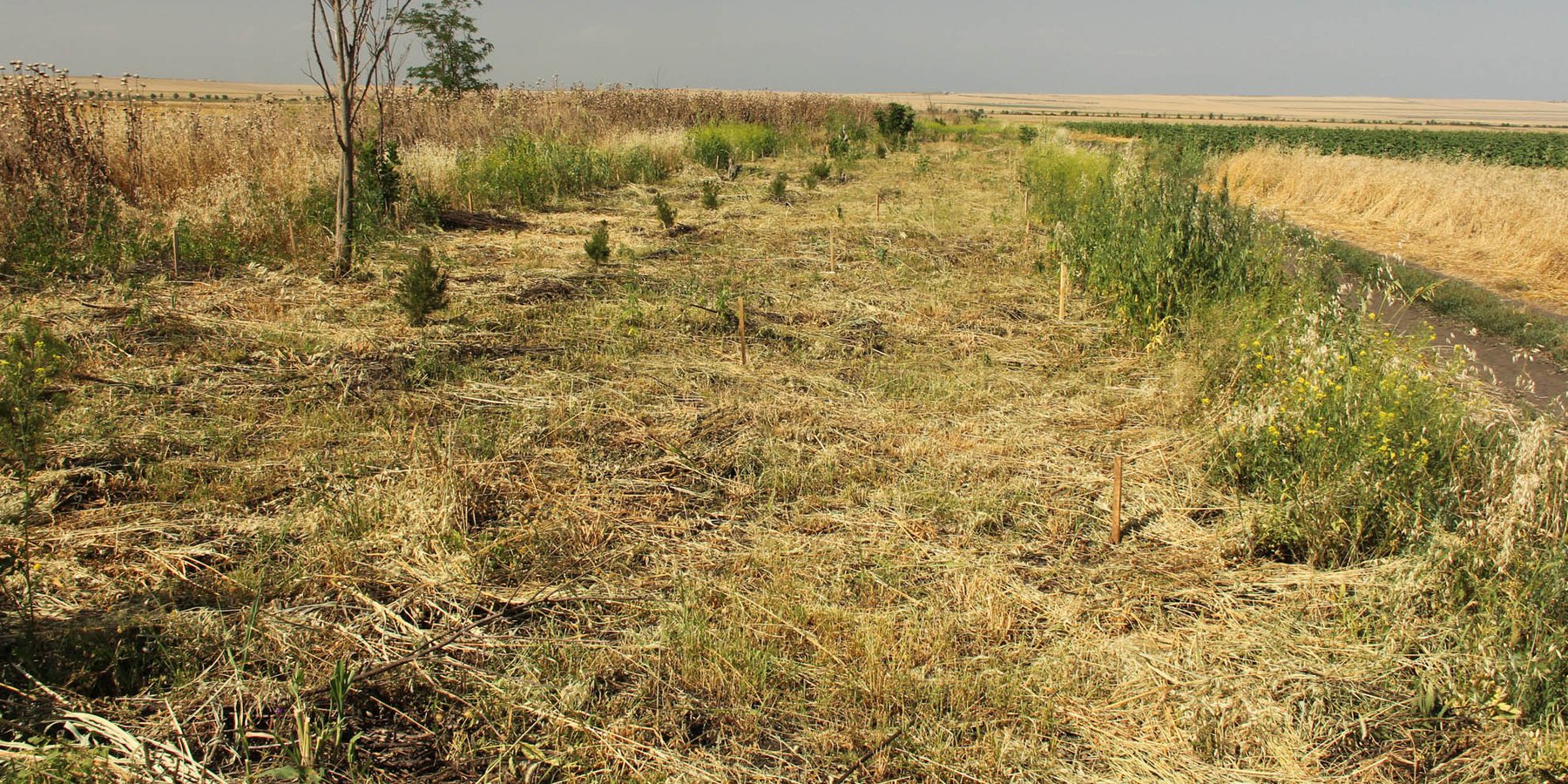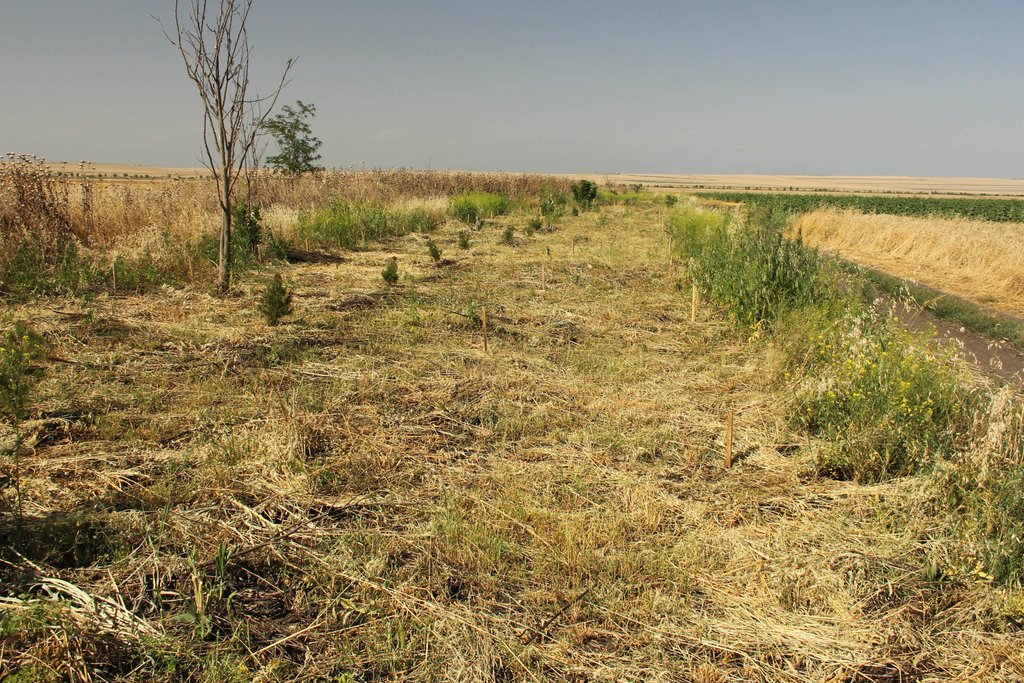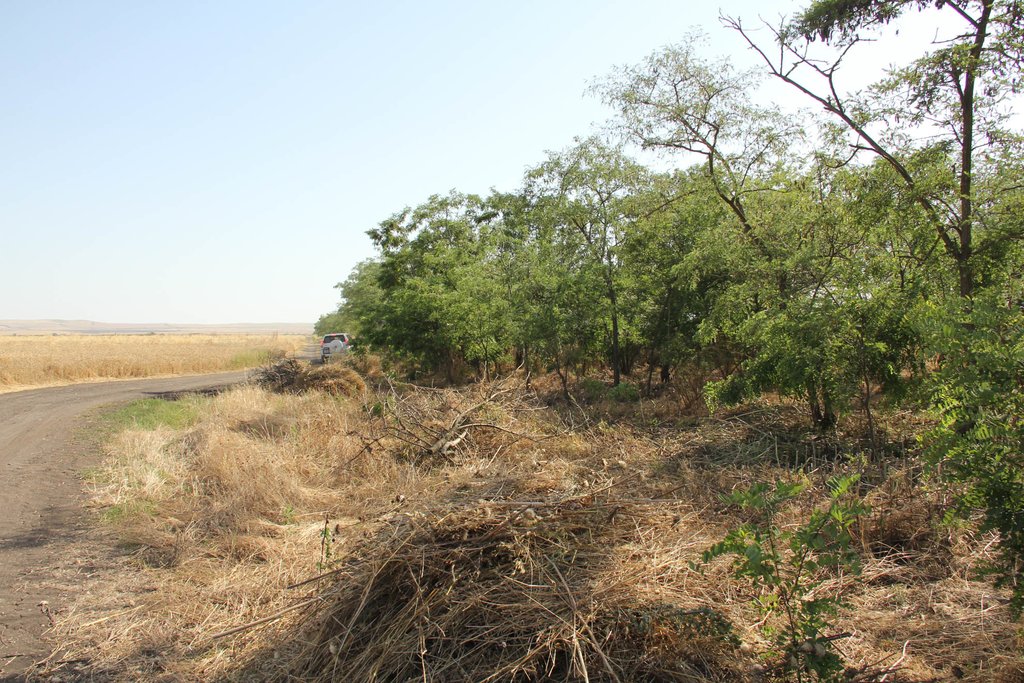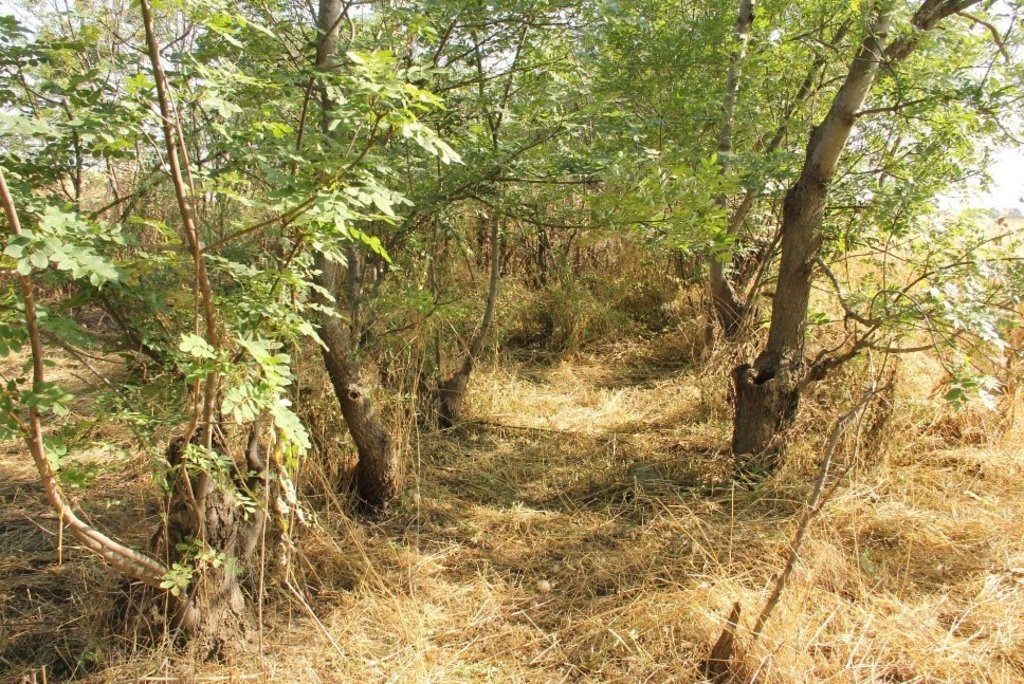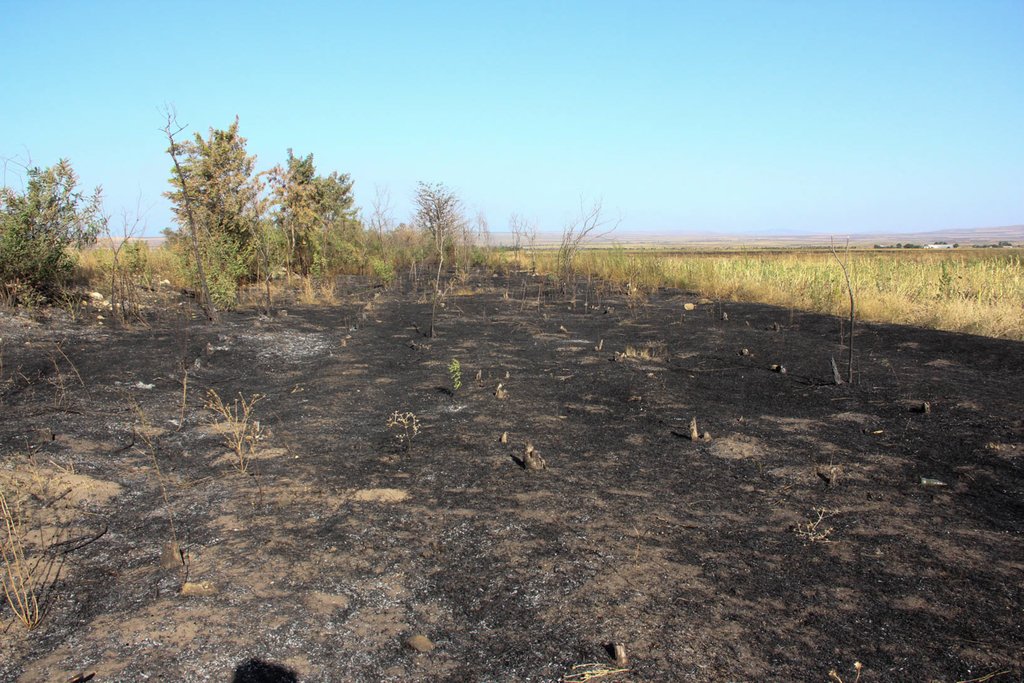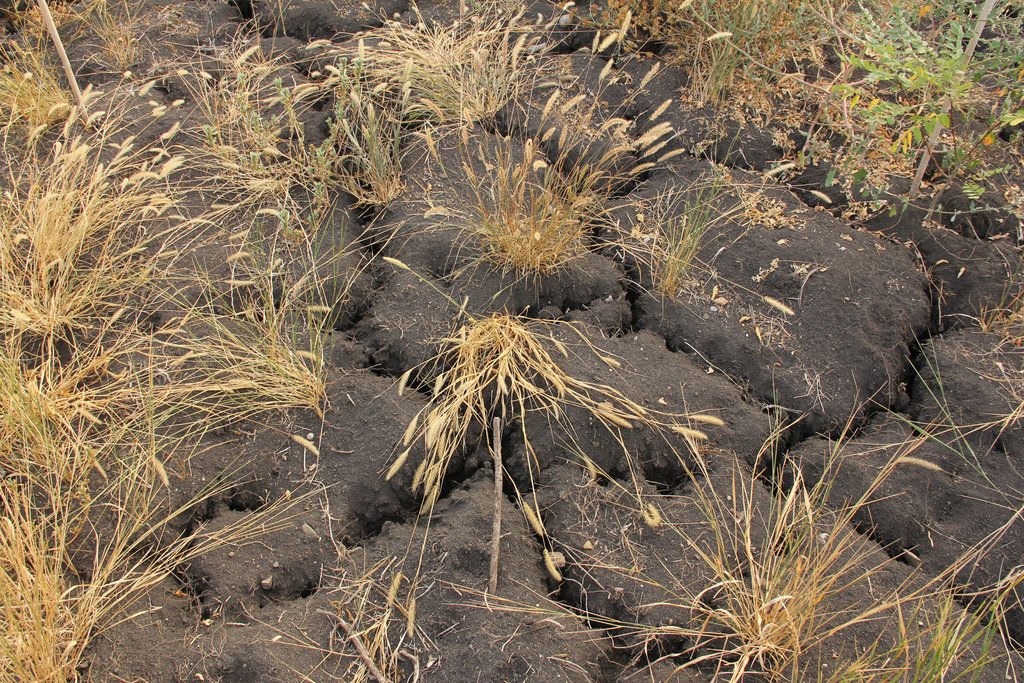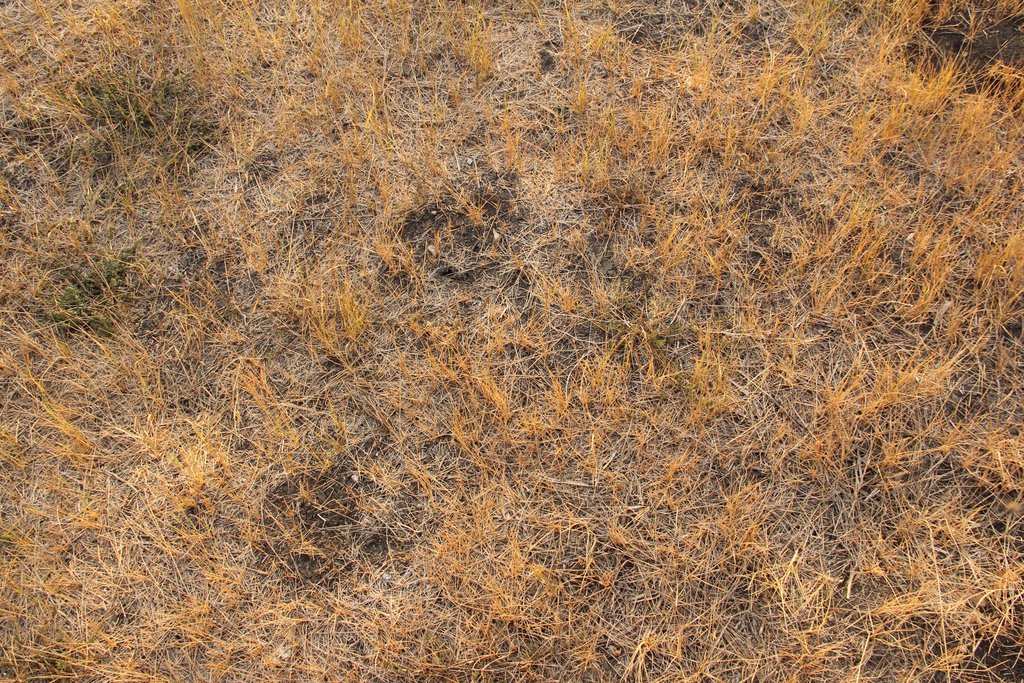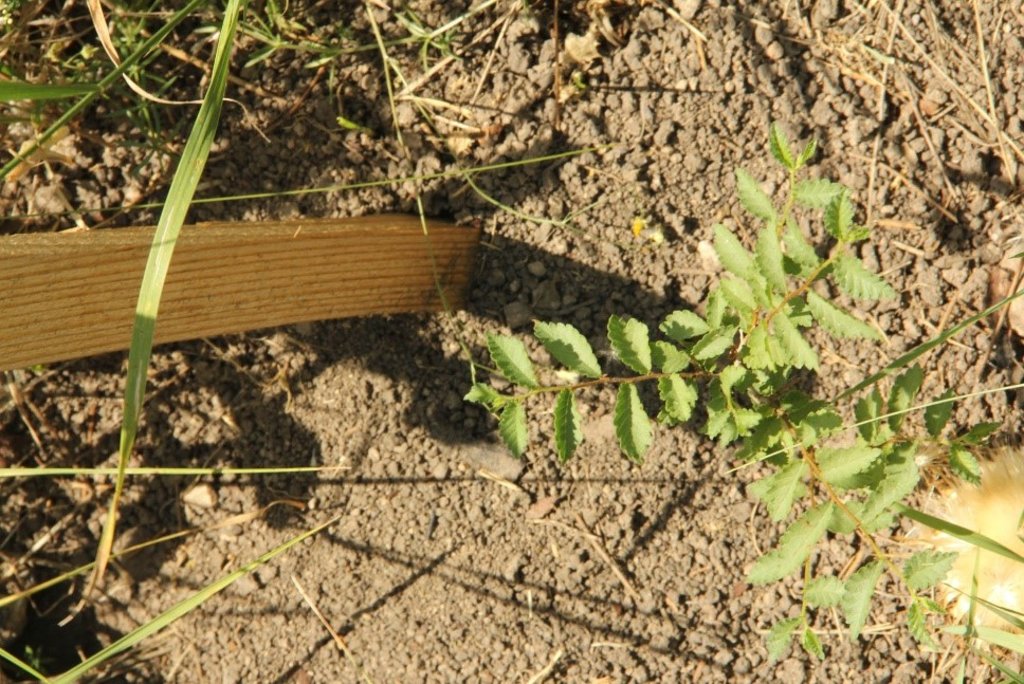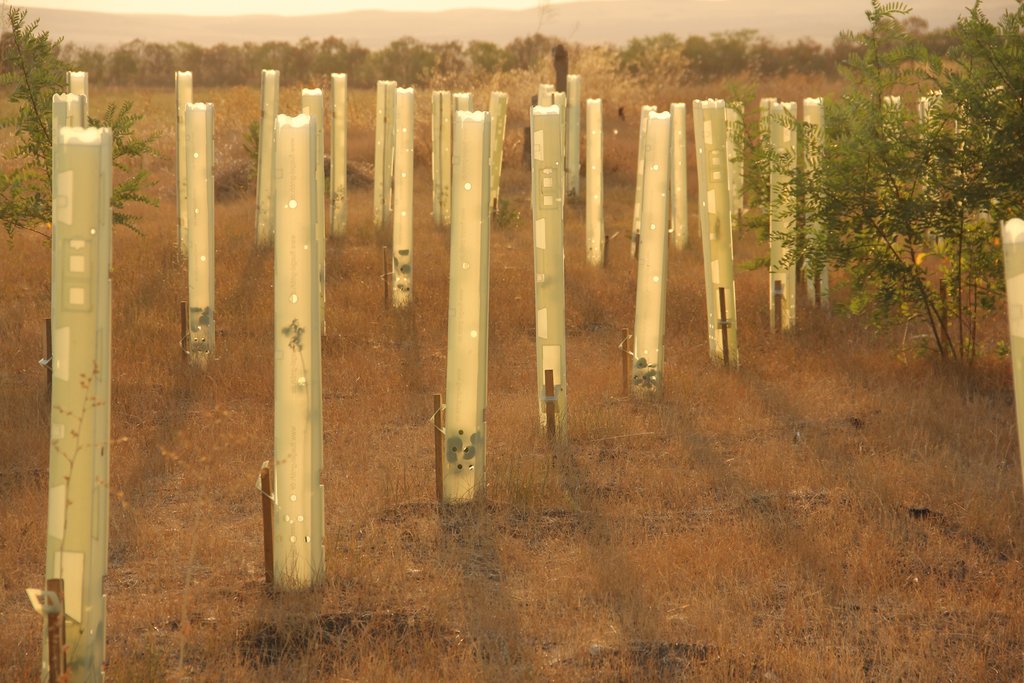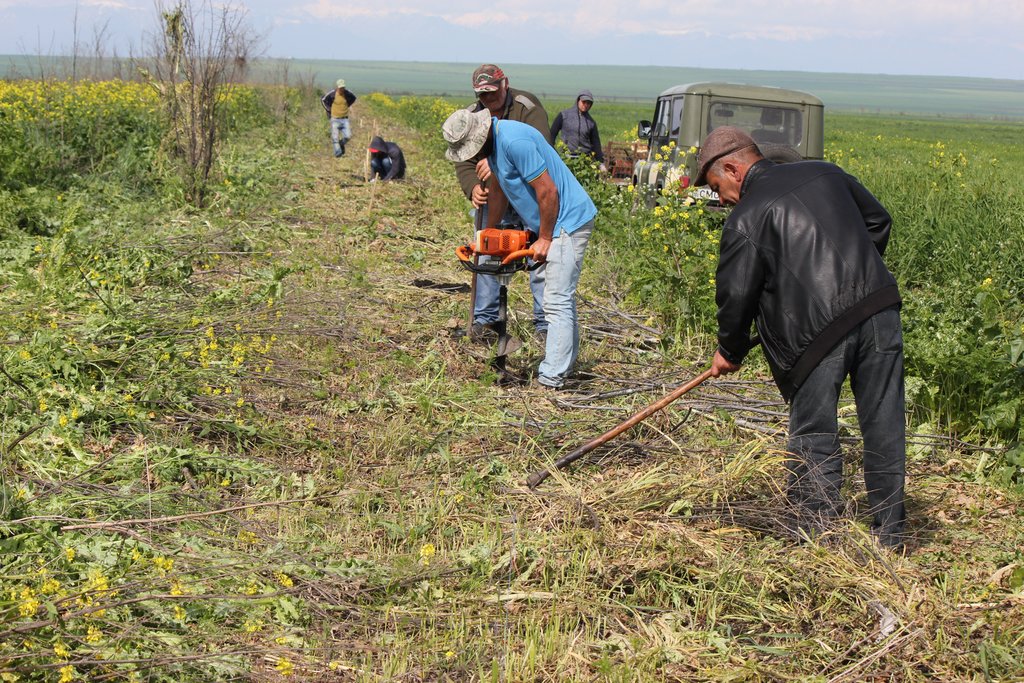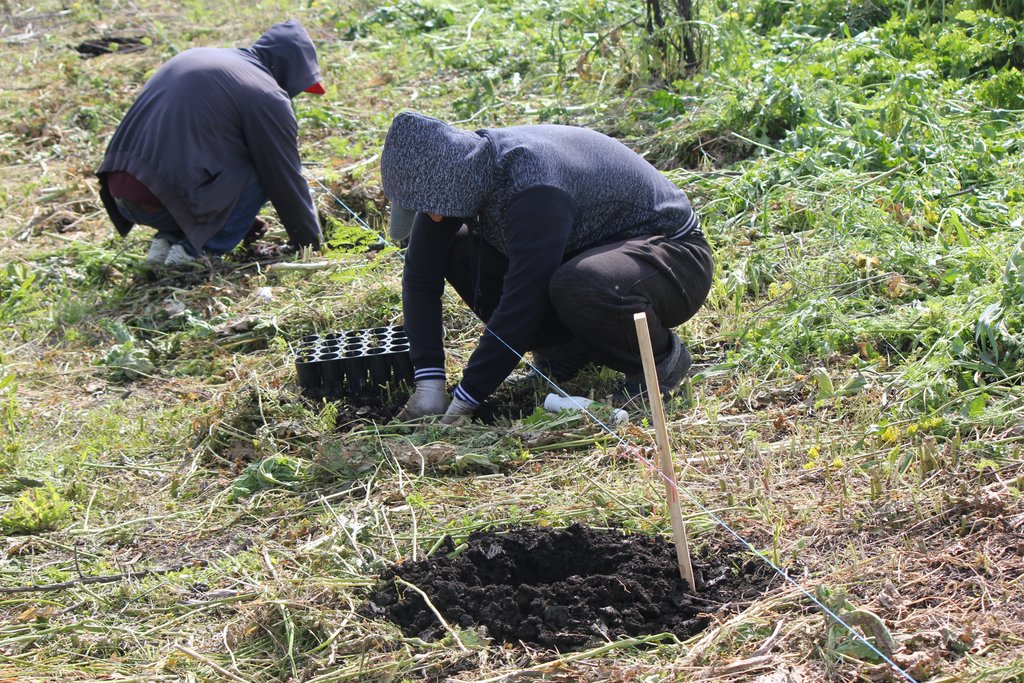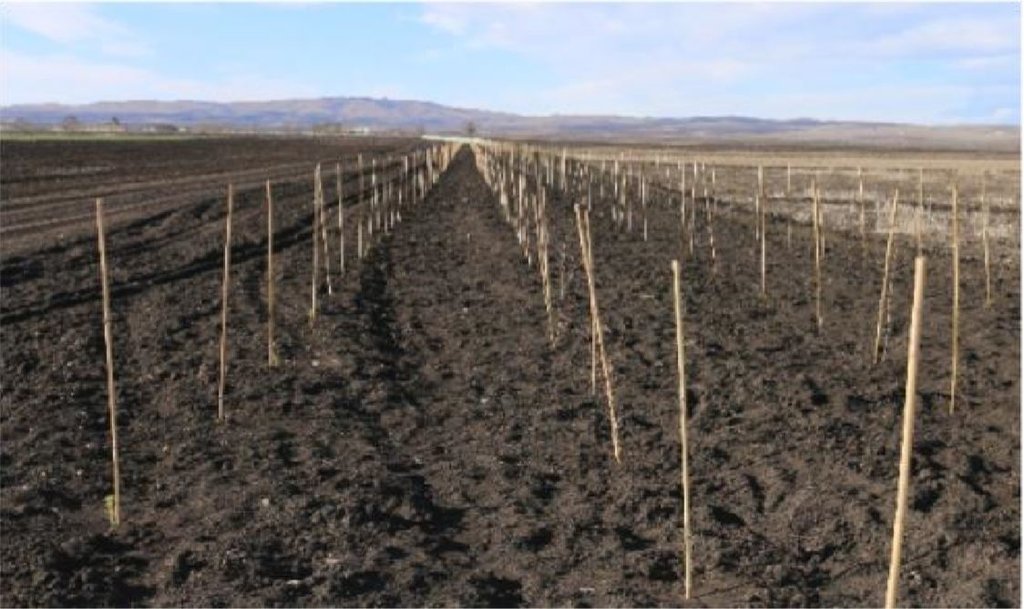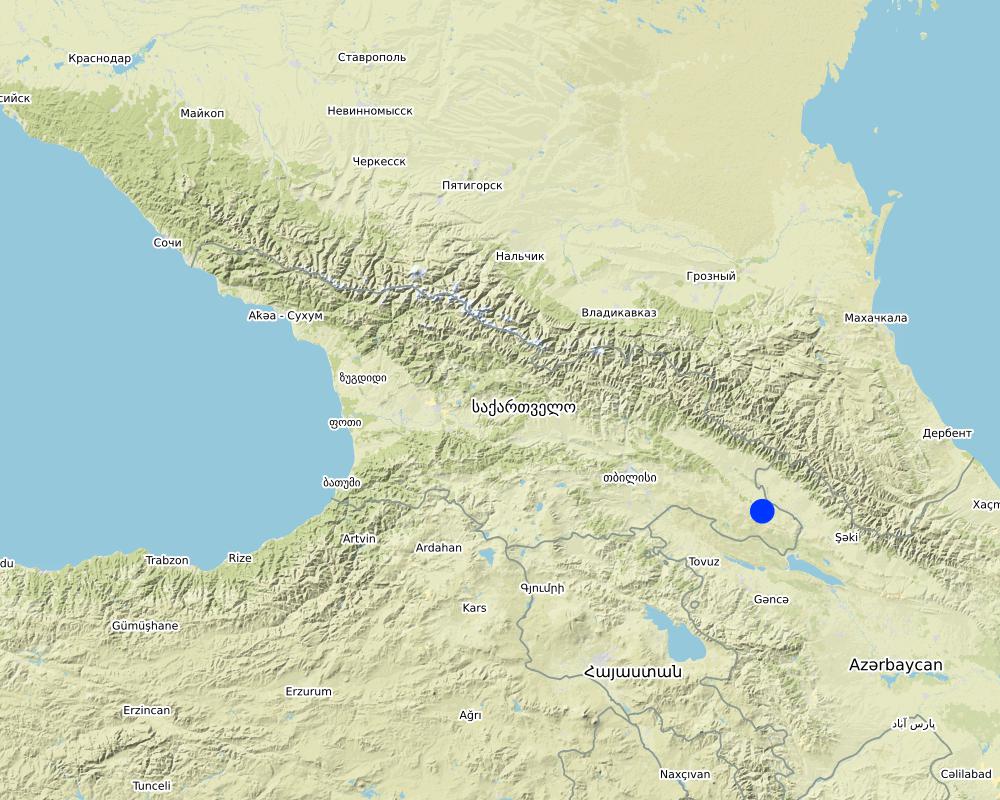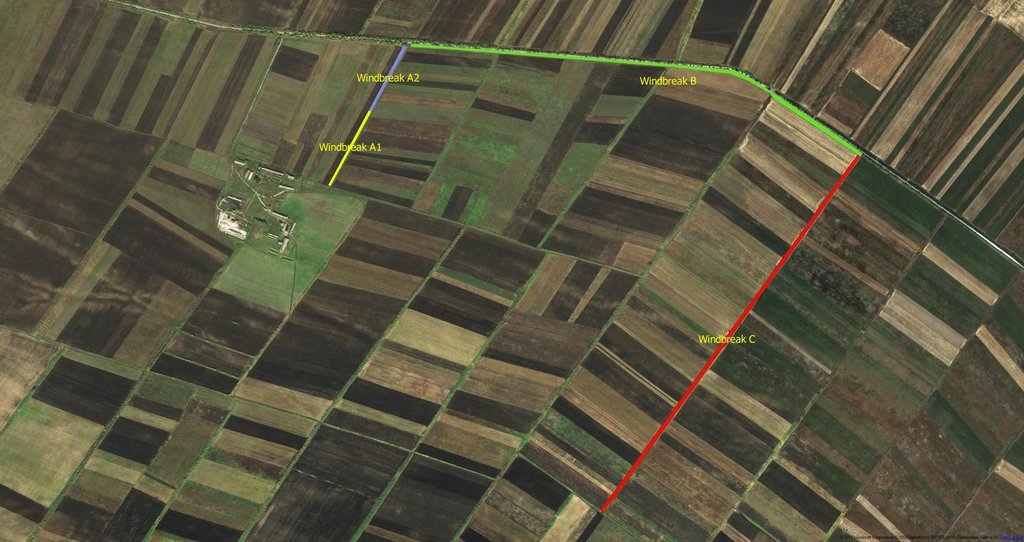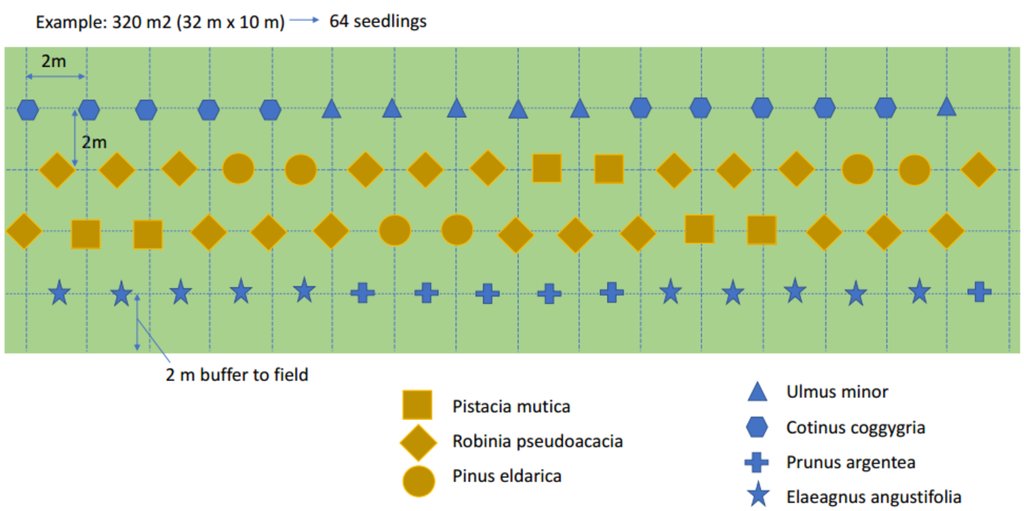Rehabilitation of Windbreaks [乔治亚]
- 创建:
- 更新:
- 编制者: Hanns Kirchmeir
- 编辑者: Kety Tsereteli
- 审查者: Rima Mekdaschi Studer
technologies_4274 - 乔治亚
查看章节
全部展开 全部收起1. 一般信息
1.2 参与该技术评估和文件编制的资源人员和机构的联系方式
co-compiler:
co-compiler:
co-compiler:
有助于对技术进行记录/评估的项目名称(如相关)
Applying Landscape and Sustainable Land Management (L-SLM) for mitigating land degradation and contributing to poverty reduction in rural area (L-SLM Project)有助于对技术进行记录/评估的机构名称(如相关)
Regional Environmental Centre for the Caucasus (REC Caucasus) - 乔治亚有助于对技术进行记录/评估的机构名称(如相关)
Deutsche Gesellschaft für Internationale Zusammenarbeit (GIZ)1.3 关于使用通过WOCAT记录的数据的条件
编制者和关键资源人员接受有关使用通过WOCAT记录数据的条件。:
是
1.4 所述技术的可持续性声明
这里所描述的技术在土地退化方面是否存在问题,导致无法被认为是一种可持续的土地管理技术?:
否
2. SLM技术的说明
2.1 技术简介
技术定义:
Windbreaks are an integrated technology to increase land productivity and biodiversity at different levels. Along six kilometres, located between a road and agricultural fields, windbreaks were rehabilitated or newly established to protect the soil wind erosion. Four lines of seedlings including seven tree species were planted in two meters distance to each other. The survival rates of different tree species have been accessed and evaluated.
2.2 技术的详细说明
说明:
Agriculture plays a key role in the economy of Georgia. 74% of wheat is produced in Kakheti. Within the region, the main wheat-growing area is Shiraki valley located in Dedoplistskaro Municipality in Eastern Georgia. The valley has deep soil with high humus content offering significant potential for high agricultural yields. Among others, wind erosion and increase of evaporation due to degradation of windbreaks have led to reduced agricultural yields. At the end of the Soviet Union, there were 1.800 km of tree windbreaks in Shiraki. More than 90% of them were destroyed either by fire or illegal cuttings for firewood. Fires are caused by farmers burning harvest residues and by shepherds burning pastures and windbreaks to facilitate the growth of new grass and clear land. Today, fire still pose the greatest threat to the rehabilitation of windbreaks. Grazing by migrating sheep and by local (cattle) herds as well as firewood extraction is still causing additional damage to windbreaks in specific areas of Shiraki valley.
In Dedoplistskaro, the SLM-pilot activities focus on the establishment of a windbreak/agroforestry system to reduce wind erosion, which is here the main degradation factor and threatens agricultural production. Windbreaks are a well-known measure against wind erosion. They consist of several rows of trees and bushes on the edges of agricultural fields to reduce the wind-speed on the surface level. Slowing down of wind-speed protects the topsoil from wind erosion. Windbreaks improve the micro-climate for crops growing in their shelter by reducing moisture loss. Windbreaks also provide shelter and habitats for a wide range of plants, pollinating insects, wildlife and birds, including predators of agricultural pests.
Selection of seedlings:
Tree species well adapted to the regional conditions (climate, soil, etc.) were selected such as Pinus (Pinus eldarica, survival rate: 90%), Pistacia (Pistacia mutica, survival rate 60%) and Elm (Ulmus minor, survival rate 60%), Wild Almond (Prunus argentea, survival rate 40%), Persian olive (Eleagnus angustifolia, survival rate: 40%) and Robinia (Robinia pseudoacacia, survival rate 16%). The survival rates are based on the assessment in September 2018, 6 months after planting.
The seeds were prepared for planting in a nursery. Seedlings to be transported over long distances must be grown in special containers to ensure good root system development and minimise damage during transport. If they are grown near the planting site and the transport time is short, seedlings may also be bare-rooted.
Preparation of soil and planting:
The pilot site of the project "Applying Landscape and Sustainable Land Management (L-SLM) for Mitigating Land Degradation and Contributing to Poverty Reduction in Rural Areas", implemented by the Regional Environment Centre for the Caucasus, is six km long and located on the main road on state-owned land. Before planting the seedlings, the vegetation (grass and herbs) was cut and removed. No ploughing was done. During the implementation in 2018, the design of the site was changed to a 6 km long U-shaped form with three 10 m wide segments of windbreaks. The total area of the pilot site is 6 ha, but since there were already intact hedges in some parts, the total area where windbreaks were either newly planted or rehabilitated is 3 ha. Each windbreak consisted of four lines of tree seedlings of different species in two meters distance to each other (inter-row spacing) and 2 m distance between the seedlings within a row (intra-row spacing). First, holes were dug (30 cm diameter, 40 cm deep), then water accumulation granulate was added to keep the water better, then the seedlings of 10-40 cm height and 2-3 years old depending on species were inserted. No compost or fertiliser was used. The seedlings were protected by plastic tubes from the cold and dry winter season. Every 2nd seedling was marked with a wooden pole to distinguish them from weeds and to control the survival rate. If the survival rate falls below 50%, the trees should be replaced. After the planting of the seedling, the herbs and grass were cut again. Further cuttings took place several times to avoid shading and competition.
Maintenance
Besides cutting of weeds for 2 times in the main growing season (Mai-July) regular watering was applied. Young seedlings should be watered 2-4 times per year (first 2 years) – about 15-20l per tree. After 2 years the root system should be established in such a way that it can take care of itself. The implementation area was not fenced, but there is no pastureland around and pressure by browsing is low.
The Regional Environment Centre for the Caucasus (REC) in cooperation with GIZ has conducted a cost-benefit analysis to estimate the value of protecting remaining windbreaks, the economic impact of banning crop residue burning and the benefits of straw as a fertilizer. The survey data shows that a ban on crop residue burning will help to protect the existing windbreaks. Consequently, shredding of straw during the harvest and subsequent incorporation of straw into the soil builds up soil organic matter and helps to retain the moisture in the ground. Unclear ownership and institutional responsibility are the most relevant constraints for sustainable windbreaks management as a measure. At the political level, issues were noted, and steps were taken: A working group under the National Forest Programme selected windbreaks restoration and protection as their key topics. The Ministry of Environmental Protection and Agriculture with the support from REC and GIZ developed a policy for rehabilitation and protection of windbreaks. Based on this, a new law on windbreaks was initiated which will clarify the situation by ascribing clear responsibilities on windbreak maintenance and management. This law is still at the stage of preparation in the Agrarian Committee.
2.3 技术照片
2.5 已应用该技术的、本评估所涵盖的国家/地区/地点
国家:
乔治亚
区域/州/省:
Kakheti
有关地点的进一步说明:
Dedoplistskaro
具体说明该技术的分布:
- 适用于特定场所/集中在较小区域
技术现场是否位于永久保护区?:
否
注释:
The intervention was done along the main road and along two side roads heading south.
Map
×2.6 实施日期
注明实施年份:
2018
2.7 技术介绍
详细说明该技术是如何引入的:
- 通过项目/外部干预
注释(项目类型等):
The rehabilitation of the windbreaks was tested on a pilot site along a highly visible road within the project "Applying Landscape and Sustainable Land Management (L-SLM) for Mitigating Land Degradation and Contributing to Poverty Reduction in Rural Areas" implemented by the Regional Environment Centre for the Caucasus (REC).
3. SLM技术的分类
3.1 该技术的主要目的
- 改良生产
- 减少、预防、恢复土地退化
- 保持/提高生物多样性
3.2 应用该技术的当前土地利用类型
同一土地单元内混合使用的土地::
是
具体说明混合土地使用(作物/放牧/树木):
- 农林业

农田
- 一年一作
年作 - 具体指明作物:
- 谷类 - 大麦
- 谷类 - 小麦(春季)
- 谷类 - 小麦(冬季)
每年的生长季节数:
- 2
采用间作制度了吗?:
否
采用轮作制度了吗?:
否

森林/林地
- 植树造林
植树造林:说明树种的起源和组成:
- 混交品种
植树造林类型:
- 温带草原人工林
树木类型:
- 松树属
- Ulmus minor, Pinus eldarica, Elaeagnus angustifolia, Cotinus coggygria , Pistacia mutica, Ulmus minor, Robinia pseudoacacia, Prunus argentea
以上的树木是落叶树还是常绿树?:
- 混合落叶或常绿
产品和服务:
- 薪材
- 自然保持/保护
- 自然灾害防护
- Protection soil from wind erosion
注释:
When the windbreak is established and dense, selective logging of firewood is possible.
3.3 由于技术的实施,土地使用是否发生了变化?
由于技术的实施,土地使用是否发生了变化?:
- 否(继续问题3.4)
3.4 供水
该技术所应用土地的供水:
- 雨养
注释:
The crop-fields are not irrigated. Only the young seedlings of the rehabilitated windbreak are irrigated 2-4 times a year in the first 2-3 years.
3.5 该技术所属的SLM组
- 农业林学
- 防风林/防护林带
3.6 包含该技术的可持续土地管理措施

植物措施
- V1:乔木和灌木覆盖层
3.7 该技术强调的主要土地退化类型

土壤风蚀
- Et:表土流失

水质恶化
- Ha:干旱化
注释:
In addition to the loss of topsoil, the reduction of wind speed and the degree of vegetation reduce the evapotranspiration rate of the crop and thereby the amount of water.
3.8 防止、减少或恢复土地退化
具体数量名该技术与土地退化有关的目标:
- 减少土地退化
注释:
The windbreak will reduce soil erosion caused by wind on neighbouring crop fields.
4. 技术规范、实施活动、投入和成本
4.1 该技术的技术图纸
技术规范(与技术图纸相关):
Planting scheme for windbreak rehabilitation.
作者:
Hanns Kirchmeir
日期:
15/11/2017
技术规范(与技术图纸相关):
Location of windbreaks along the main and side roads. During implementation the design of the site was changed to an u-shaped form built by 3 windbreaks. The windbreaks that are included in the rehabilitation were segmented into four:
Windbreak A1 - Replanting new seedlings - 458 length (m);
Windbreak A2 - Removal of dry biomass - 403 length (m);
Windbreak B - Replanting new seedlings - 2.560 length (m);
Windbreak C - Replanting new seedlings - 2.354 length (m).
While in the segments A1, B and C the tree cover is very low and new seedlings are needed, in segment A2 there is still a dense crown cover.
To protect the existing trees in segment A2, the dry biomass under the crown (dry herbs and grass, dead trees & branches) was removed to reduce the amount of fuel in the case of a fire. This process was just started at the north end of A2.
In Segment B Pistacia mutica, Ulmus minor, Robinia pseudoacacia, Cotinus coggygria and Wild almond (Prunus argentea) have been planted.
In Segment C Pinus eldarica, Elaeagnus angustifolia Pistacia mutica, Ulmus minor, Robinia pseudoacacia and Wild almond (Prunus argentea) have been planted.
作者:
Hanns Kirchmeir
日期:
15/09/2017
技术规范(与技术图纸相关):
Planting scheme for windbreaks rehabilitation.
The distance between the lines is 2m and the distance between seedlings within a line is also 2m. About every second seedling is marked with a wooden pole (50 cm). This is done on the one hand to control the survival rate (if every second seedling is, the next seedling is only 2m away and easy to find) and on the other hand to identify and leave the seedlings standing when the weeds are cleared.
作者:
Hanns Kirchmeir
4.2 有关投入和成本计算的一般信息
具体说明成本和投入是如何计算的:
- 每个技术区域
注明尺寸和面积单位:
3 ha
其它/国家货币(具体说明):
GEL
如相关,注明美元与当地货币的汇率(例如1美元=79.9巴西雷亚尔):1美元=:
2.7
注明雇用劳工的每日平均工资成本:
15 USD
4.3 技术建立活动
| 活动 | 时间(季度) | |
|---|---|---|
| 1. | Marking sites in the field | April-May |
| 2. | Cut grass and remove dead wood | April |
| 3. | Planting of seedlings (planting, adding wooden poles and water accumulation granulate | April-May |
| 4. | Irrigation and weed-cutting | July, August (to be repeated for 3 years) |
| 5. | Scientific Monitoring | October - October (five years) |
4.4 技术建立所需要的费用和投入
| 对投入进行具体说明 | 单位 | 数量 | 单位成本 | 每项投入的总成本 | 土地使用者承担的成本% | |
|---|---|---|---|---|---|---|
| 劳动力 | Clearing and preparation of sites (3 ha) | person days | 40.0 | 30.0 | 1200.0 | 0.0 |
| 劳动力 | Weed cutting 2 x on 3 ha | person days | 110.0 | 36.0 | 3960.0 | 0.0 |
| 劳动力 | Planting of 7.300 seedlings (digging hole, adding water accumulation granulate, planting seedling, adding wooden pole and tube) | person days | 73.0 | 45.0 | 3285.0 | 0.0 |
| 劳动力 | Irrigation 4 x 7.300 seedlings | person days | 73.0 | 75.0 | 5475.0 | 0.0 |
| 设备 | Wooden poles | pieces | 7300.0 | 0.9 | 6570.0 | 0.0 |
| 设备 | Water accumulation granulate | kg | 73.0 | 70.0 | 5110.0 | 0.0 |
| 设备 | Water for irrigation | m³ | 300.0 | 3.0 | 900.0 | 0.0 |
| 设备 | Transport of water (water truck) | applications | 4.0 | 1300.0 | 5200.0 | 0.0 |
| 植物材料 | Pistacia mutica | pieces | 470.0 | 3.0 | 1410.0 | 0.0 |
| 植物材料 | Robinia pseudoacacia | pieces | 1825.0 | 1.0 | 1825.0 | 0.0 |
| 植物材料 | Pinus eldarica | pieces | 117.0 | 5.0 | 585.0 | 0.0 |
| 植物材料 | Ulmus minor | pieces | 1355.0 | 2.0 | 2710.0 | 0.0 |
| 植物材料 | Amygdalus communis | pieces | 1238.0 | 1.0 | 1238.0 | 0.0 |
| 植物材料 | Elaeagnus angustifolia | pieces | 1237.0 | 0.75 | 927.75 | 0.0 |
| 其它 | Transportation of workers and materials by lorry | transfers | 50.0 | 60.0 | 3000.0 | 0.0 |
| 技术建立所需总成本 | 43395.75 | |||||
| 技术建立总成本,美元 | 16072.5 | |||||
如果土地使用者负担的费用少于100%,请注明由谁负担其余费用:
GEF-Funds have been used to finance all of the activities
4.5 维护/经常性活动
| 活动 | 时间/频率 | |
|---|---|---|
| 1. | Watering the seedlings | Every 2-3 weeks during dry period in July-September |
| 2. | Preparing fire-break around windbreak | August, after harvesting the crops |
| 3. | Weed cutting between seedlings | 1-2 times between June and August |
| 4. | Replacing dead trees by new seedlings (if needed) | October/November |
注释:
Here the maintenance is applied in the second year. Irrigation and weed cutting of the first year are already integrated in the establishment costs.
4.6 维护/经常性活动所需要的费用和投入(每年)
| 对投入进行具体说明 | 单位 | 数量 | 单位成本 | 每项投入的总成本 | 土地使用者承担的成本% | |
|---|---|---|---|---|---|---|
| 劳动力 | Weed cutting 2 times on 3 ha | person days | 110.0 | 37.0 | 4070.0 | 0.0 |
| 劳动力 | Irrigation 4*7.300 seedlings | person days | 73.0 | 75.0 | 5475.0 | 0.0 |
| 劳动力 | Protect firebreak around windbreak | person days | 4.0 | 100.0 | 400.0 | 0.0 |
| 设备 | Water (10l/seedling*4) | m³ | 300.0 | 3.0 | 900.0 | 0.0 |
| 设备 | Transport of water (water truck) | application | 4.0 | 1300.0 | 5200.0 | 0.0 |
| 技术维护所需总成本 | 16045.0 | |||||
| 技术维护总成本,美元 | 5942.59 | |||||
如果土地使用者负担的费用少于100%,请注明由谁负担其余费用:
The full costs were covered by the project
注释:
The maintenance costs are calculated for the second year
4.7 影响成本的最重要因素
描述影响成本的最决定性因素:
How often weeds need to be cut, survival rate of trees
5. 自然和人文环境
5.1 气候
年降雨量
- < 250毫米
- 251-500毫米
- 501-750毫米
- 751-1,000毫米
- 1,001-1,500毫米
- 1,501-2,000毫米
- 2,001-3,000毫米
- 3,001-4,000毫米
- > 4,000毫米
指定年平均降雨量(若已知),单位为mm:
697.00
有关降雨的规范/注释:
The driest month is January, with 25 mm of rainfall. The greatest amount of precipitation occurs in June, with an average of 108 mm. The difference in precipitation between the driest month and the wettest month is 83 mm.
注明所考虑的参考气象站名称:
Dedoplistskaro Met. Station
农业气候带
- 半干旱
The climate is warm and temperate in Dedoplistskaro. The average annual temperature in Dedoplistskaro is 11.3 °C. The warmest month of the year is July, with an average temperature of 22.7 °C. The lowest average temperatures in the year occur in January, when it is around 0.1 °C.
5.2 地形
平均坡度:
- 水平(0-2%)
- 缓降(3-5%)
- 平缓(6-10%)
- 滚坡(11-15%)
- 崎岖(16-30%)
- 陡峭(31-60%)
- 非常陡峭(>60%)
地形:
- 高原/平原
- 山脊
- 山坡
- 山地斜坡
- 麓坡
- 谷底
垂直分布带:
- 0-100 m a.s.l.
- 101-500 m a.s.l.
- 501-1,000 m a.s.l.
- 1,001-1,500 m a.s.l.
- 1,501-2,000 m a.s.l.
- 2,001-2,500 m a.s.l.
- 2,501-3,000 m a.s.l.
- 3,001-4,000 m a.s.l.
- > 4,000 m a.s.l.
说明该技术是否专门应用于:
- 不相关
5.3 土壤
平均土层深度:
- 非常浅(0-20厘米)
- 浅(21-50厘米)
- 中等深度(51-80厘米)
- 深(81-120厘米)
- 非常深(> 120厘米)
土壤质地(表土):
- 细粒/重质(粘土)
土壤质地(地表以下> 20厘米):
- 细粒/重质(粘土)
表土有机质:
- 高(>3%)
如有可能,附上完整的土壤描述或具体说明可用的信息,例如土壤类型、土壤酸碱度、阳离子交换能力、氮、盐度等。:
The soils are clay rich Chernosems and Kastanosems.
5.4 水资源可用性和质量
地下水位表:
5-50米
地表水的可用性:
匮乏/没有
水质(未处理):
良好饮用水
水质请参考::
地下水
水的盐度有问题吗?:
否
该区域正在发生洪水吗?:
否
关于水质和水量的注释和进一步规范:
There is no local access to water. The water for irrigation had to be moved from the village 15 km away.
5.5 生物多样性
物种多样性:
- 低
栖息地多样性:
- 低
关于生物多样性的注释和进一步规范:
The windbreaks add important habitat diversity to the landscape. They act as corridors, breeding and feeding habitat especially for small mammals and birds.
5.6 应用该技术的土地使用者的特征
定栖或游牧:
- 定栖的
生产系统的市场定位:
- 混合(生计/商业)
非农收入:
- 低于全部收入的10%
相对财富水平:
- 贫瘠
个人或集体:
- 个人/家庭
机械化水平:
- 机械化/电动
性别:
- 男人
土地使用者的年龄:
- 中年人
5.7 应用该技术的土地使用者使用的平均土地面积
- < 0.5 公顷
- 0.5-1 公顷
- 1-2 公顷
- 2-5公顷
- 5-15公顷
- 15-50公顷
- 50-100公顷
- 100-500公顷
- 500-1,000公顷
- 1,000-10,000公顷
- > 10,000公顷
这被认为是小规模、中规模还是大规模的(参照当地实际情况)?:
- 小规模的
5.8 土地所有权、土地使用权和水使用权
土地所有权:
- 州
- 个人,有命名
土地使用权:
- 租赁
- 个人
土地使用权是否基于传统的法律制度?:
是
5.9 进入服务和基础设施的通道
健康:
- 贫瘠
- 适度的
- 好
教育:
- 贫瘠
- 适度的
- 好
技术援助:
- 贫瘠
- 适度的
- 好
就业(例如非农):
- 贫瘠
- 适度的
- 好
市场:
- 贫瘠
- 适度的
- 好
能源:
- 贫瘠
- 适度的
- 好
道路和交通:
- 贫瘠
- 适度的
- 好
饮用水和卫生设施:
- 贫瘠
- 适度的
- 好
金融服务:
- 贫瘠
- 适度的
- 好
6. 影响和结论性说明
6.1 该技术的现场影响
社会经济效应
生产
作物生产
注释/具体说明:
The positive effect on crop yields will be visible when trees in the windbreak get higher than 3 meters.
木材生产
注释/具体说明:
First harvest of firewood is expected in 15-20 years
生态影响
水循环/径流
蒸发
注释/具体说明:
Due to an expected reduction in wind speed near the ground, the evaporation rate is expected to decrease after the trees have reached a height of more than 5 m. So far, no data from measurements are available.
土壤
土壤水分
注释/具体说明:
Due to an expected reduction in wind speed near the ground, the evapotranspiration rate is expected to decrease after the trees have reached a height of more than 5 m, which would lead to an increase in soil moisture. So far, no data from measurements are available.
土壤流失
注释/具体说明:
Due to the reduction in wind speed, it is expected that the amount of soil erosion caused by wind will decrease when the trees have reached a height of more than 5 m.
生物多样性:植被、动物
植物多样性
注释/具体说明:
Windbreaks are refuge areas for plant species sensitive to herbicides and plowing.
动物多样性
注释/具体说明:
The windbreaks provide shelter and breeding habitat for birds and small mammals. Tree litter improves soil conditions and has positive effect on soil-invertebrate diversity.
减少气候和灾害风险
风速
注释/具体说明:
The expected impact is a reduction of wind velocity up to 200 m after the windbreak, which will lead to reduced wind erosion of top soil. This effect is related to tree height and will need 2-3 decades to gain full impact.
微气候
注释/具体说明:
The expected impact is a reduction of wind velocity up to 200m after the windbreak, which will lead to a decrease in evaporation. This effect is related to tree height and will need 2-3 decades to gain full Impact.
6.2 该技术的场外影响已经显现
风力搬运沉积物
注释/具体说明:
By reducing the wind speed, the amount of soil erosion by wind is expected to decrease when the trees have reached a height of more than 5 m. The positive influence on the neighbouring field can be observed up to a distance of twice the height of the trees.
对邻近农田的破坏
注释/具体说明:
By reducing the wind speed, the amount of soil erosion by wind is expected to decrease when the trees have reached a height of more than 5 m. The positive influence on the neighbouring field can be observed up to a distance of twice the height of the trees.
温室气体的影响
SLM之前的数量:
10 t CO2-eqiv/ha
SLM之后的数量:
200 t CO2-eqiv/ha
注释/具体说明:
The increase in the volume of wood on the windbreak increases carbon storage in the ecosystem. The rehabilitation of a completely destroyed windbreak can increase the biomass volume by 100-200 m³/ha, which corresponds to 100-200 t carbon dioxide.
6.3 技术对渐变气候以及与气候相关的极端情况/灾害的暴露和敏感性(土地使用者认为的极端情况/灾害)
渐变气候
渐变气候
| 季节 | 增加或减少 | 该技术是如何应对的? | |
|---|---|---|---|
| 年温度 | 增加 | 好 | |
| 年降雨量 | 减少 | 适度 |
注释:
Only drought resistant tree species have been selected. But during the first years after planting the root system is not well developed and irrigation is recommended.
6.4 成本效益分析
技术收益与技术建立成本相比如何(从土地使用者的角度看)?
短期回报:
消极
长期回报:
稍微积极
技术收益与技术维护成本/经常性成本相比如何(从土地使用者的角度看)?
短期回报:
消极
长期回报:
积极
注释:
It is a significant investment to establish a windbreak and it takes several years (5-10) before the measure will show effects on the increase of crop fields' productivity. But when established, the windbreak does not need investment for maintenance but can deliver additional benefit (fuel wood).
6.5 技术采用
- 1-10%
在所有采用这项技术的人当中,有多少人是自发的,即未获得任何物质奖励/付款?:
- 0-10%
6.6 适应
最近是否对该技术进行了修改以适应不断变化的条件?:
是
若是,说明它适应了哪些变化的条件:
- 气候变化/极端气候
具体说明技术的适应性(设计、材料/品种等):
The selection of tree species and planting technologies was adapted to the rising temperatures. Special protection tubes against winter storms were used.
6.7 该技术的优点/长处/机会
| 土地使用者眼中的长处/优势/机会 |
|---|
| Increase of yields in the neighbouring fields |
| Availability of firewood |
| 编制者或其他关键资源人员认为的长处/优势/机会 |
|---|
| Seedlings can be produced locally in tree nurseries using local tree species. |
| Increase of protection from wind erosion and drought by wind impact. |
| Increase of habitat diversity |
6.8 技术的弱点/缺点/风险及其克服方法
| 土地使用者认为的弱点/缺点/风险 | 如何克服它们? |
|---|---|
| Fires | protecting the windbreak by ploughing the soil along the line |
| Lack of maintenance of planted seedlings | cutting the grass and removing it from the field, continue mulching and watering the seedlings over the next few years, replanting the dead seedlings |
| 编制者或其他关键资源人员认为的弱点/缺点/风险 | 如何克服它们? |
|---|---|
| High investment for seedlings, wooden poles and irrigation | It is much cheaper to protect existing windbreaks from burning. Integrating fruit trees and/or vegetables into the windbreak can result in a faster return on investment. |
7. 参考和链接
7.1 信息的方法/来源
- 实地考察、实地调查
Field visits have been done in summer 2017 and 2018
- 与SLM专业人员/专家的访谈
Kety Tsereteli | REC Caucasus , Amiran Kodiashvili, GIZ GE , Georgi Gambashidze
- 根据报告和其他现有文档进行编译
Project Reports from national and international experts (REC-Caucasus). Reports from GIZ - IBiS Program on windbreak Rehabilitation Pilot Project.
(现场)数据是什么时候汇编的?:
01/09/2018
7.2 参考可用出版物
标题、作者、年份、ISBN:
Applying Landscape and Sustainable Land Management (L-SLM) for mitigating land degradation and contributing to poverty reduction in rural areas - Implementation Evaluation Report June 2018 – Windbreaks.
7.3 链接到网络上的相关信息
标题/说明:
Approach for “Rehabilitation of Windbreaks in East Georgia”
URL:
https://biodivers-southcaucasus.org/uploads/files/Approach%20Windbreak%20Rehabilitation%20Georgia.pdf
链接和模块
全部展开 全部收起链接
无链接
模块
无模块


